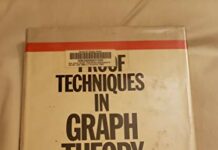
Ebook Info
- Published: 1965
- Number of pages: 415 pages
- Format: PDF
- File Size: 29.19 MB
- Authors: Frank Harary
Description
John Wiley & Sons 2nd printing 1966 green hardcover 415pp
User’s Reviews
Reviews from Amazon users which were colected at the time this book was published on the website:
⭐the best introduction ever read
⭐In the early ’70’s I took a course in sociological research methods that was organized around this book and included unpublished material by Harrison White as ancillary reading. The theory of directed graphs is as abstract and difficult as most other forms of mathematics, and the book is remarkably short on concrete applications to discerning the structural character of organized social settings.Though the book was published in the mid-’60’s, most of the end-of-chapter citations are from the ’40’s and ’50’s. At the time I read it, I got the distinct imprssion that the theory of directed graphs had been investigated in preceding decades and was found to lack promise for sociological research.The instructor who taught the course was very good at working with this material, and I recall him solving a problem pertaining to identification of equivalent social roles using data collected in a monastery, replicating an analysis reported by White and one his graduate students, Francois Lorraine. (The analysis has since been reported in article form in The Journal of Mathematical Sociology.) The solution seemed to make sense, but its value struck me as alarmingly dubious. When I gave voice to my reservations, I was advised by the instructor, as well as some of the other students in the class, that I might not be well-suited for a career in sociology, and they were right.Nearly forty years later, the theory of directed graphs and related topics in mathematics are still studied by social scientists, and still provide challenges for sociologists with an aptitude for mathematics. Harrison White, moreover, has become an influential social theorist, based largely on his work in social network analysis, an endeavor that is informed by graph theory but leans most heavily on computational algorithms that cumulate interaction patterns, thereby defining the social location of each entity relative to all others. The complexity of the networks is evident in the appearance of methodological articles reporting faster algorithms for identifying positions in networks.Now that social network analysis is represented among Sage’s little green paperbacks, perhaps it has come of age. However, I know of only one recent textbook on mathematical sociology, as an over-arching framework for social network analysis, that by Bonacich and Lu (2012). Surely, if there were widespread interest in mathematical sociology generally, publishers would be trying a lot harder to make money from it. As it is, if one does a Google search for “mathematical sociology,” Coleman’s 1964 book enjoys the most conspicuous place. Top drawer sociology journals have long given undue attention to the most abstrusely technical topics around. It’s easy to be misled by their penchant for the obscure, and hard not to feel as if one may have been relegated to obsolescence. When almost all the articles are methodological rather than substantive, however, it pays to be suspicious.Though the concepts “graph theory” and “social structure” share an intuitively appealing ring, it’s not at all evident that the joining of the two has substantially improved our understanding of the organization of social life. This judgment may reflect my lack of interest and advancing age, but I think it unwise for most sociological aspirants to invest the time and effort needed to master the theory of directed graphs. The promise that at first seemed so obvious just isn’t there. On the other hand, if you just like math, this is a good book. If you really have a flair for this sort of thing, a career in the prestigious, even if sterile, sub-discipline of mathematical sociology may be in your future.By the way, I have no objection to unfavorable ratings given to this review, but I would be grateful if someone would tell me what I’m missing.
Keywords
Free Download Structural Models: An Introduction to the Theory of Directed Graphs in PDF format
Structural Models: An Introduction to the Theory of Directed Graphs PDF Free Download
Download Structural Models: An Introduction to the Theory of Directed Graphs 1965 PDF Free
Structural Models: An Introduction to the Theory of Directed Graphs 1965 PDF Free Download
Download Structural Models: An Introduction to the Theory of Directed Graphs PDF
Free Download Ebook Structural Models: An Introduction to the Theory of Directed Graphs



